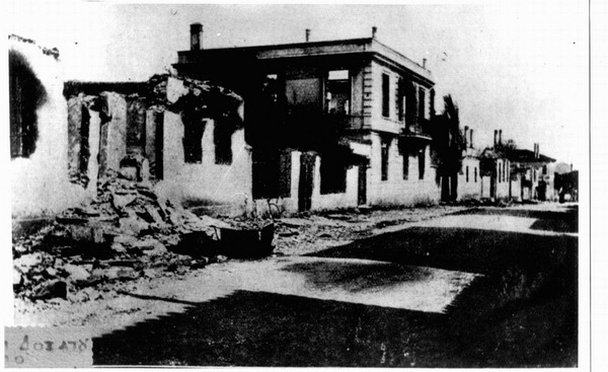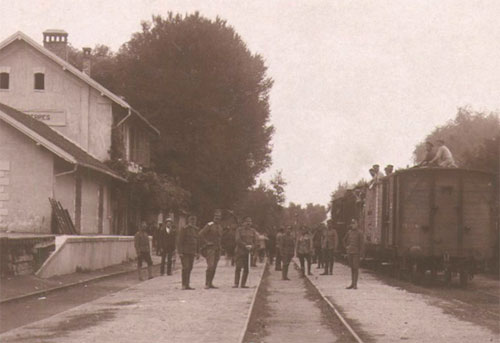The Bulgarian national flag in front of City Hall in Drama, photo: proinos-typos.gr
World War II was the most recent military conflict, in which all the Balkan countries were involved. But although many of the participants in the events of that time were alive until recently, this time from the common history of Bulgaria and Greece is one of the least discussed in Bulgarian public debate.
GRReporter has been consistently interested in sensitive moments of both the recent and distant past of the two countries. Today, we talk with researcher Vassilis Tzanakaris about events in the regions of Drama, Xanthi, Kavala and Serres in the autumn of 1941.

Dzanakaris is the author of many historical studies, including a history of his native city of Serres. He is currently working on a book of the same topic. Its title is ‘Greece in Flames’, and it is expected to hit the market next year. The story starts with the invasion of Eastern Macedonia by German and Bulgarian troops and ends with the December 1944 events in Athens.
Dzanakaris has interviewed plenty of participants in those events. The outcome is an impartial and generous narrative presenting the cruelty of the military conflict that shook Europe to its core.
The pogroms that followed the Drama rebellion of 29 September 1941
Everything started with the Drama rebellion in late September 1941. Several Bulgarians were murdered in the town, and the insurgency was drowned in blood straight after that.
It is also believed that in the early hours of 29 September armed men from Fotolivos came into the village, captured the Bulgarian mayor and took him to the mountains. This case, as well as the murders of Bulgarians, gave the reason for the Bulgarian authorities – which ruled the occupied regions of Eastern Macedonia and Thrace at the time – to embark on a clampdown, in order to take revenge, and also to prevent similar insurgencies in the future.
Even though no official data has been made available, there is evidence to suggest that roughly 300 people were killed in Drama. On 29 September, Doxato’s residential areas were fired upon by military troops. A Bulgarian company came into the village and the troops corralled all its residents into an area called Pevkakya. The old men, women and children were locked inside the school, and the executions began; around 270 inhabitants of Doxato were killed.
Similar repressions were laid on the villages of Agios Athanasios, Kirgia, Terpsithea, Platanovrissi, Paliambela, Platania, Kalifitos, Neo Kalapodi, Piges, Drimotopos, Hamokerasia, Echinos, Adriani and many others. 15 young people from Choristi village were taken outside Drama and executed there. 21 residents of Nikiforos were shot in the village square. The clampdown went on until mid October 1941.
In the afternoon on 29 September, two planes bombed and strafed the village of Prosotsani. The number of dead and wounded was high, many houses burned down.
The list of villages continues - Mikropoli, Kali Vrisi, Pourshovo, Agiochori, Kalos Agros, Megalokambos, Vathilakkos, Sitagri, Koudounia, Fotolivos, Kokkinogia. Reprisals have taken place in the region of Xanthi, Kavala and Serres. For example, these were the numbers of victims in the Kavala area: 10 in Kavala itself, 17 in Philippi, 5 in Karies, 3 in Piges, 2 Haydevto, 10 in Krinides, 7 in Akropotamos and 3 in Nea Peramos.
Around 580 people were detained in the town of Serres, and some of them were murdered. The villages around town were also the site of executions.

A burned house in Doxato
The victims
The exact number of victims is difficult to ascertain. Bulgarian patrols killed people straight away whenever they found them, without court trials or keeping any kind of records. Eye witnesses say that in one single case a patrol in Amphipolis executed 50 people while they were trying to flee into the German occupation zone.
While still under occupation, Professor Alexandros Svolos, who later served as president of the Political Committee of National Liberation and his assistant Konstantinos Karamanlis created the Committee of Macedonians and Thracians in Athens. In October 1941, Svolos wrote that 12,000 people were killed during repressions committed by the Bulgarian troops. This was the number specified in the report, which the Committee forwarded to Altenburg and Gidzi, the Regents of the two occupying powers, Germany and Italy.
The German collaborator Athanasios Chrysochoou, appointed as military governor of the Thessaloniki district, put the number of victims at 5000. The same figure is quoted by a few more sources of that time. Other sources say the number of victims was between 6,000 and 7,000. These discrepancies make the precise number a matter of speculation.

Bulgarian soldiers at Serres railway station, photo: central municipal library in Serres
‘Refugees’ from the Bulgarian to the German occupation zone
The number of people who were fleeing in droves to the so-called ‘free Greece’ further swelled after the massacres.